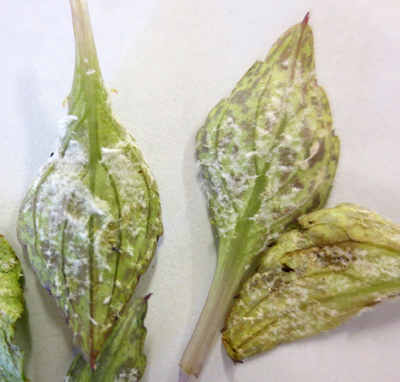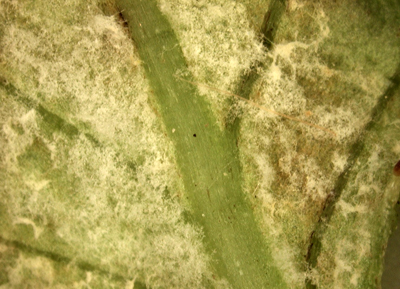Under the Scope Feature
Impatiens Downy Mildew
July 2013
...it is not yet known how long oospores of P. obducens will survive in the soil.
Impatiens downy mildew is a disease infecting all varieties of Impatiens walleriana. It is caused by Plasmopara obducens, an oomycete, and has become a devastating pest of greenhouse grown impatiens over the past few years. The impatiens downy mildew pathogen can also survive in the landscape where oospores may remain viable in the soil to infect new plantings in subsequent years. Downy Mildew thrives in moist, humid, or cool conditions, and infections may occur any time leaves remain wet for four or more hours.
 If noticed early, symptoms may consist of just a few leaves that appear slightly chlorotic or stippled and over time become completely yellow. A white, downy-like growth is most likely present on the underside of yellow leaves but can also be found on the underside of some green leaves. As the disease progresses, leaves drop prematurely leaving stems bare. Plants that are infected at an early stage of development may experience reduced growth and leaf expansion.
If noticed early, symptoms may consist of just a few leaves that appear slightly chlorotic or stippled and over time become completely yellow. A white, downy-like growth is most likely present on the underside of yellow leaves but can also be found on the underside of some green leaves. As the disease progresses, leaves drop prematurely leaving stems bare. Plants that are infected at an early stage of development may experience reduced growth and leaf expansion.
The pathogen can be spread short distances by water splash from infected plants and greater distances by airborne spores that are carried by the wind. It can also be spread from oospores that overwinter in the soil. Although it is not yet known how long oospores of P. obducens will survive in the soil, oospores of other Plasmopara spp. are reported to remain viable for up to 10 years.
As the development of impatiens downy mildew is favored by wet and cool conditions it tends to be worse in very dense planting beds and locations where leaves stay wet for extended periods of time (i.e. shady locations, beds receiving overhead sprinkler irrigation, etc.).
Although some fungicides are labeled for downy mildew management in the  home garden, they may offer only short-term protection of healthy plants, as applications may need to be re-applied every seven days. If impatiens downy mildew is found in the landscape, it may spread quickly so entire infected plants should be removed and disposed of when found. Composting the infected plant material is not recommended.
home garden, they may offer only short-term protection of healthy plants, as applications may need to be re-applied every seven days. If impatiens downy mildew is found in the landscape, it may spread quickly so entire infected plants should be removed and disposed of when found. Composting the infected plant material is not recommended.
Gardeners are encouraged to replace impatiens with another bedding plant such as begonias or New Guinea impatiens. For more information, several fact sheets are available online, including some from Cornell Coop. Ext. of Suffolk Co., UMass Amherst Extension, and the Ball Hort. Co.
CU-PPDC News Feed
Diagnostic review reports and the latest lab updates delivered directly to you. Learn how!
